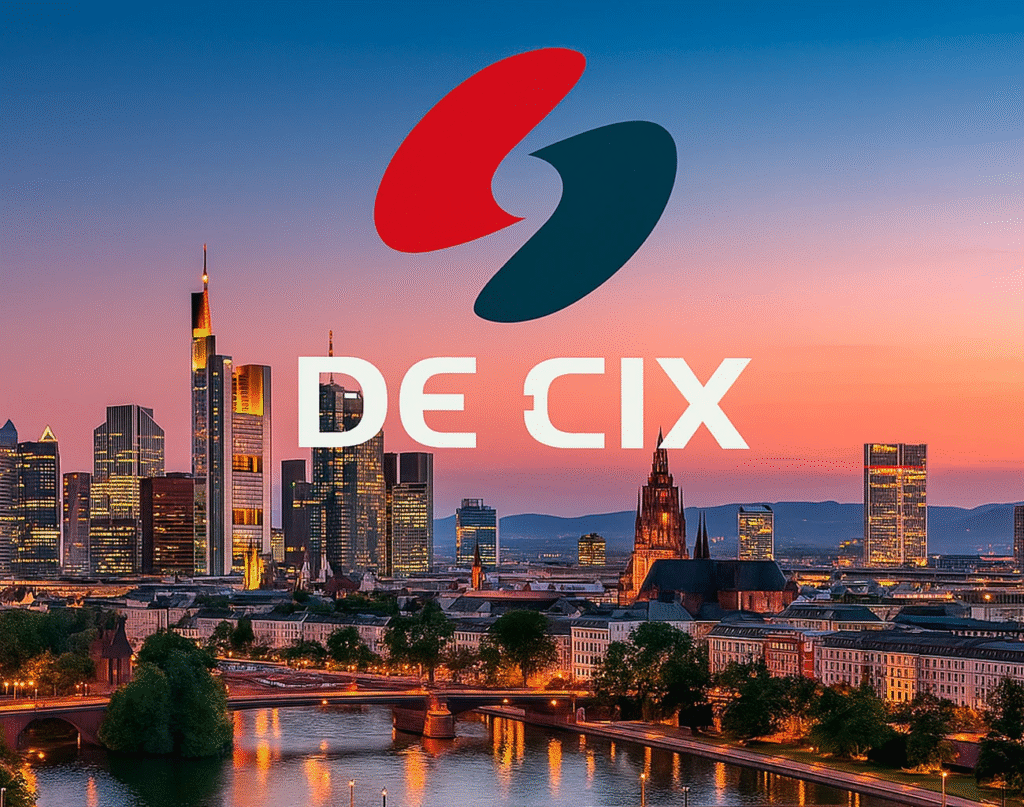DE-CIX (Deutscher Commercial Internet Exchange) is the world’s largest platform for Internet traffic exchange between telecommunications operators, data centers, cloud providers, and corporate networks. These exchange points, known as IXPs (Internet Exchange Points), enable direct interconnection between networks without involving transit providers, making data transmission faster, more reliable, and more cost-efficient.
The modern Internet relies on the interaction of thousands of autonomous systems (AS), each managed by a separate operator or organization. To allow data to flow between these systems without unnecessary intermediate routes, IXPs are used. Founded in Germany, DE-CIX has become one of the key components of this infrastructure, facilitating traffic exchange between participants worldwide.
Today, a significant share of global Internet traffic passes through DE CIX. The platform is recognized for its scalability, high data transmission speeds, and fault tolerance. Thanks to its advanced infrastructure and neutral status, DE-CIX ensures efficient routing, minimal latency, and exceptional connection reliability, making it a critical element of the global Internet ecosystem.
What Is DE-CIX
DE-CIX (Deutscher Commercial Internet Exchange) is a neutral Internet traffic exchange platform that connects thousands of networks across the globe. Its primary goal is to enable direct data exchange between autonomous systems (AS) owned by Internet service providers, data centers, cloud platforms, content delivery networks, and corporate clients.
Founded in 1995 in Frankfurt am Main, the organization has evolved into the world’s largest Internet exchange point by data throughput. Today, DE-CIX operates more than 50 exchange points in various countries, including Germany, the United States, Spain, Portugal, India, the United Arab Emirates, and Singapore. This extensive presence ensures geographical distribution and high connectivity availability.
DE-CIX operates on a principle of full neutrality — it is not owned by any telecom operator and is independent of commercial interests. This guarantees equal conditions for all participants and makes DE-CIX a reliable partner for organizations of any scale.
The central DE-CIX hub in Frankfurt is considered one of the most powerful in the world. Its capacity exceeds tens of terabits per second, and its infrastructure is continuously upgraded to meet the growing demands of global data traffic. Furthermore, DE-CIX actively implements technologies that optimize routing, enhance security, and improve service quality.
The DE-CIX ecosystem includes thousands of participants — from large telecommunications carriers and global content providers to regional ISPs and enterprise networks. All of them use DE-CIX for direct and secure data exchange, increasing efficiency and reducing the load on external transit channels.
How DE-CIX Works
The operation of DE-CIX is based on the technology of peering — a direct exchange of traffic between networks without involving transit providers. In the traditional routing model, data is transmitted through several external operators, which increases both latency and transmission costs. Peering, on the other hand, allows networks to interconnect directly through DE-CIX’s shared infrastructure, shortening the data path and improving the efficiency of communication.
Each DE-CIX participant connects to the platform through one of its partner data centers, where DE-CIX networking equipment is installed. Once connected, the customer gains access to a backbone infrastructure consisting of high-performance, carrier-grade switches and routers. These devices support data transmission capacities of up to hundreds of terabits per second.
Peering can be implemented in two main forms:
- Public peering — traffic exchange among multiple participants through a shared platform. This is the most common model, as it allows networks to connect to a large number of peers simultaneously.
- Private peering — a direct connection between two participants for exchanging large volumes of data or achieving an additional layer of security.
DE-CIX employs a multi-layered network architecture with redundancy across equipment, links, and data centers. This ensures fault tolerance and uninterrupted data exchange even in the event of individual component failures.
Special attention is given to connection security. DE-CIX implements mechanisms for DDoS mitigation and route filtering. Among them are the Blackholing system, which allows temporary blocking of malicious traffic, and the Route Server Security service, designed to prevent routing errors and unauthorized prefix announcements.
In addition to standard peering, DE-CIX provides Cloud Exchange services that enable enterprises to establish secure, low-latency connections to major cloud platforms such as Microsoft Azure, AWS, and Google Cloud.
Thus, DE-CIX serves as a high-tech intermediary that provides fast, secure, and predictable connectivity between networks, reducing costs while improving the quality of global Internet traffic.
Key Benefits of DE-CIX
DE-CIX holds a unique position among global Internet Exchange Points (IXPs) thanks to its combination of technical excellence, high reliability, and worldwide scalability. Below are the key advantages that make this platform one of the most important components of modern Internet infrastructure.
1. Low latency and high data transfer speed
Through direct interconnection between networks and geographically optimized routing, DE-CIX ensures minimal latency during data transmission. For real-time services such as streaming video, cloud applications, online gaming, or financial transactions, this is a critical factor.
2. Reliability and fault tolerance
The DE-CIX infrastructure is built on the principle of redundancy. Every element — from routers to communication channels — is duplicated to guarantee continuous operation even in the event of partial failures. All platform nodes are equipped with backup power sources and automatic failover systems.
3. Cost efficiency
Using peering through DE-CIX allows participants to significantly reduce expenses on international transit. Instead of paying external providers for data transmission, companies exchange traffic directly, making network operations more economical and predictable in terms of cost.
4. Security and connection protection
DE-CIX offers built-in mechanisms for network threat mitigation. Route filtering and Blackholing systems prevent the spread of malicious traffic and minimize the effects of DDoS attacks. In addition, all connections are managed according to carrier-grade security standards.
5. Scalability and connection flexibility
The platform supports ports of various capacities — from 1 to 400 Gbit/s — enabling participants to adapt their infrastructure to individual requirements. Scaling can be performed without downtime or hardware replacement, which is especially important for fast-growing companies and telecom operators.
6. Global ecosystem
DE-CIX connects thousands of networks worldwide — from regional ISPs to the largest global operators and cloud platforms. Participants gain access to a vast peering environment that spans Europe, North America, Asia, and the Middle East.
7. Technological leadership and innovation
DE-CIX continuously develops advanced solutions for peering automation and monitoring. Among these are systems for real-time routing management and direct cloud connectivity services. This makes DE-CIX one of the most technologically advanced platforms in the industry.
Use Cases and Examples

DE-CIX is used across various sectors of the digital economy — from telecommunications and cloud services to media platforms and financial institutions. With its high capacity, reliability, and security, the platform has become a global standard for interconnection among companies worldwide.
- Telecommunications operators and Internet providersFor telecom operators, DE-CIX serves as a central traffic exchange hub through which connections with other networks are established. This reduces international transit costs and ensures high-quality Internet connectivity for end users. Peering through DE-CIX also helps optimize routing paths, minimizing latency and improving network performance.
- Content platforms and CDN servicesCompanies that distribute multimedia content actively use DE-CIX to deliver data to users quickly and reliably. The platform enables direct connections to the networks of operators and ISPs, improving streaming stability and content delivery speeds. For large CDN providers, DE-CIX is a critical element of infrastructure that supports seamless global content distribution.
- Cloud providers and enterprise clientsDE-CIX offers a Cloud Exchange service that allows organizations to connect directly to cloud platforms such as Microsoft Azure, Amazon Web Services, and Google Cloud. This approach reduces latency, enhances security, and simplifies the integration of corporate systems with cloud environments.
- Financial sectorBanks, exchanges, and payment systems rely on DE-CIX for secure data transmission between branches and data centers across regions. For these organizations, both speed and security are crucial. Connecting through DE-CIX ensures isolated, low-latency links, which are essential for high-frequency transaction systems.
- Government and research institutionsCertain governmental bodies and research centers connect to DE-CIX to exchange large volumes of data between networks and data processing facilities. The platform offers confidentiality, stability, and high throughput — all critical for scientific and state-level projects.
- International companies with distributed infrastructureFor corporations with offices and data centers located in multiple countries, DE-CIX functions as a global interconnection platform. It enables centralized management of data flows and ensures fast, secure communication between departments and partners.
The Role of DE-CIX in the Global Network Ecosystem
DE-CIX is one of the core infrastructure platforms of the global Internet, providing stable and secure data exchange among thousands of networks worldwide. Thanks to its neutrality, technological reliability, and flexible connectivity, DE-CIX has become the standard for telecom operators, content providers, cloud platforms, and enterprise networks.
Its role extends beyond traffic routing — it contributes to the overall resilience and stability of the Internet. The platform enables direct connections between participants, reducing latency, lowering costs, and enhancing security. As a result, organizations using DE-CIX gain access to a fast, scalable, and secure interconnection infrastructure — a fundamental requirement for operating modern digital services.



